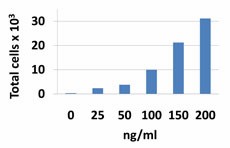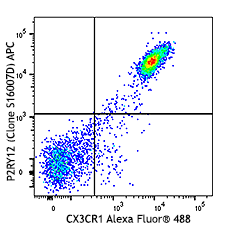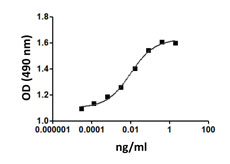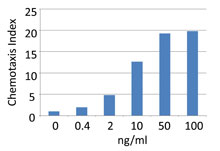- Regulatory Status
- RUO
- Other Names
- Mammary enriched chemokine (MEC)
- Ave. Rating
- Submit a Review
- Product Citations
- publications

-

Baf3-hCCR10 transfectants chemoattracted by mouse CCL28.
| Cat # | Size | Price | Quantity Check Availability | Save | ||
|---|---|---|---|---|---|---|
| 584704 | 25 µg | $253 | ||||
| 584706 | 100 µg | $686 | ||||
Select size of product is eligible for a 40% discount! Promotion valid until December 31, 2024. Exclusions apply. To view full promotion terms and conditions or to contact your local BioLegend representative to receive a quote, visit our webpage.
Mouse CCL28 was identified in an EST database using a human chemokine consensus sequence. CCL28 is constitutively expressed by mucosal epithelial cells such as exocrine glands, trachea, and colon. Acinar epithelial cells in human and mouse salivary glands are strongly positive for CCL28 by immunostaining, and human saliva and milk contain high concentrations of CCL28. Furthermore, it is known that human and mouse CCL28 have antimicrobial activity against Candida albicans, Gram-negative bacteria, and Gram-positive bacteria, and the the C terminus of human CCL28 is responsible for this property. In addition, using a CCR10 deficient mouse model, it was shown that CCR10 plays a critical role in localization and accumulation of IgA ASC to the lactating mammary gland. Also, it has been described that CCL28 is upregulated in epithelial inflammation and this upregulation allows the recruitment of T regs expressing CCR10. In fact, a subpopulation of CCR10-expressing CD25+CD4+Foxp3+ Tregs with potent anti-inflammatory properties was isolated from chronically inflamed human liver. Most recent information suggested that tumour hypoxia promotes the recruitment of Treg cells through induction of expression of CCL28, and this induction is mediated by the hypoxia inducible factor-1α (HIF-1α). Therefore, tumour hypoxia promotes tolerance and angiogenesis via CCL28 and Treg cells.
Product DetailsProduct Details
- Source
- Mouse CCL28, amino acids Met- Ile23-Arg130 (Accession# NM_020279.3) was expressed in E. coli.
- Molecular Mass
- The 109 amino acid recombinant protein has a predicted molecular mass of approximately 12.4 kD. The DTT-reduced protein migrates at approximately 15 kD and non-reduced protein migrates at 18 kD by SDS-PAGE. The N-terminal amino acid is Methionine.
- Purity
- >98%, as determined by Coomassie stained SDS-PAGE.
- Formulation
- 0.22 µm filtered protein solution is in 10 mM NaH2PO4, 0.15 M NaCl, pH7.2.
- Endotoxin Level
- Less than 0.01 ng per µg cytokine as determined by the LAL method.
- Concentration
- 10 and 25 µg sizes are bottled at 200 µg/mL. 100 µg size and larger sizes are lot-specific and bottled at the concentration indicated on the vial. To obtain lot-specific concentration and expiration, please enter the lot number in our Certificate of Analysis online tool.
- Storage & Handling
- Unopened vial can be stored between 2°C and 8°C for up to 2 weeks, at -20°C for up to six months, or at -70°C or colder until the expiration date. For maximum results, quick spin vial prior to opening. The protein can be aliquoted and stored at -20°C or colder. Stock solutions can also be prepared at 50 - 100 µg/mL in appropriate sterile buffer, carrier protein such as 0.2 - 1% BSA or HSA can be added when preparing the stock solution. Aliquots can be stored between 2°C and 8°C for up to one week and stored at -20°C or colder for up to 3 months. Avoid repeated freeze/thaw cycles.
- Activity
- Bioactivity was measured by its property to chemoattract BaF3-hCCR10 transfectants in a dose dependent manner.
- Application
-
Bioassay
- Application Notes
-
BioLegend carrier-free recombinant proteins provided in liquid format are shipped on blue-ice. Our comparison testing data indicates that when handled and stored as recommended, the liquid format has equal or better stability and shelf-life compared to commercially available lyophilized proteins after reconstitution. Our liquid proteins are verified in-house to maintain activity after shipping on blue ice and are backed by our 100% satisfaction guarantee. If you have any concerns, contact us at tech@biolegend.com.
Antigen Details
- Structure
- Chemokine
- Distribution
-
Mucosal epithelial cells
- Function
- CCL28 chemoattracts resting CD4 and CD8 cells, and IgA antibody secreting cells. It plays a role in extravasation of IgA ASC in the small intestine, colon, and lactating mammary gland, and has antimicrobial activity. CCL28 is upregulated by IL-1 or n-butirate in human colon epithelial cell lines, and IL-1 and n-butirate have a synergistic effect on CCL28 upregulation. Hypoxia induces CCL28 in tumors.
- Interaction
- CD4 and CD8 T cells, IgA antibody secreting cells, CCR10-expressing CD25+CD4+Foxp3+ Tregs
- Ligand/Receptor
- CCR10, CCR3
- Biology Area
- Cell Biology, Signal Transduction
- Molecular Family
- Cytokines/Chemokines
- Antigen References
-
1. Wang W, et al. 2000. J. Biol. Chem. 275:22313.
2. Hieshima K, et al. 2003. J. Immunol. 170:1452.
3. Hieshima K, et al. 2004. J. Immunol. 173:3668.
4. Ogawa H, et al. 2004. Am. J. Physiol. Gastrointest. Liver Physiol. 287:G1062.
5. Eksteen B, et al. 2006. J. Immunol. 177:593.
6. Morteau O, et al. 2008. J. Immunol. 181:6309.
7. Liu B and Wilson E. 2010. Eur. J. Immunol. 40:186.
8. Facciabene A, et al. 2011. Nature 475:226. - Gene ID
- 56838 View all products for this Gene ID
- UniProt
- View information about CCL28 on UniProt.org
Related FAQs
- Why choose BioLegend recombinant proteins?
-
• Each lot of product is quality-tested for bioactivity as indicated on the data sheet.
• Greater than 95% Purity or higher, tested on every lot of product.
• 100% Satisfaction Guarantee for quality performance, stability, and consistency.
• Ready-to-use liquid format saves time and reduces challenges associated with reconstitution.
• Bulk and customization available. Contact us.
• Learn more about our Recombinant Proteins. - How does the activity of your recombinant proteins compare to competitors?
-
We quality control each and every lot of recombinant protein. Not only do we check its bioactivity, but we also compare it against other commercially available recombinant proteins. We make sure each recombinant protein’s activity is at least as good as or better than the competition’s. In order to provide you with the best possible product, we ensure that our testing process is rigorous and thorough. If you’re curious and eager to make the switch to BioLegend recombinants, contact your sales representative today!
- What is the specific activity or ED50 of my recombinant protein?
-
The specific activity range of the protein is indicated on the product datasheets. Because the exact activity values on a per unit basis can largely fluctuate depending on a number of factors, including the nature of the assay, cell density, age of cells/passage number, culture media used, and end user technique, the specific activity is best defined as a range and we guarantee the specific activity of all our lots will be within the range indicated on the datasheet. Please note this only applies to recombinants labeled for use in bioassays. ELISA standard recombinant proteins are not recommended for bioassay usage as they are not tested for these applications.
- Have your recombinants been tested for stability?
-
Our testing shows that the recombinant proteins are able to withstand room temperature for a week without losing activity. In addition the recombinant proteins were also found to withstand four cycles of freeze and thaw without losing activity.
- Does specific activity of a recombinant protein vary between lots?
-
Specific activity will vary for each lot and for the type of experiment that is done to validate it, but all passed lots will have activity within the established ED50 range for the product and we guarantee that our products will have lot-to-lot consistency. Please conduct an experiment-specific validation to find the optimal ED50 for your system.
- How do you convert activity as an ED50 in ng/ml to a specific activity in Units/mg?
-
Use formula Specific activity (Units/mg) = 10^6/ ED50 (ng/mL)
 Login/Register
Login/Register 














Follow Us